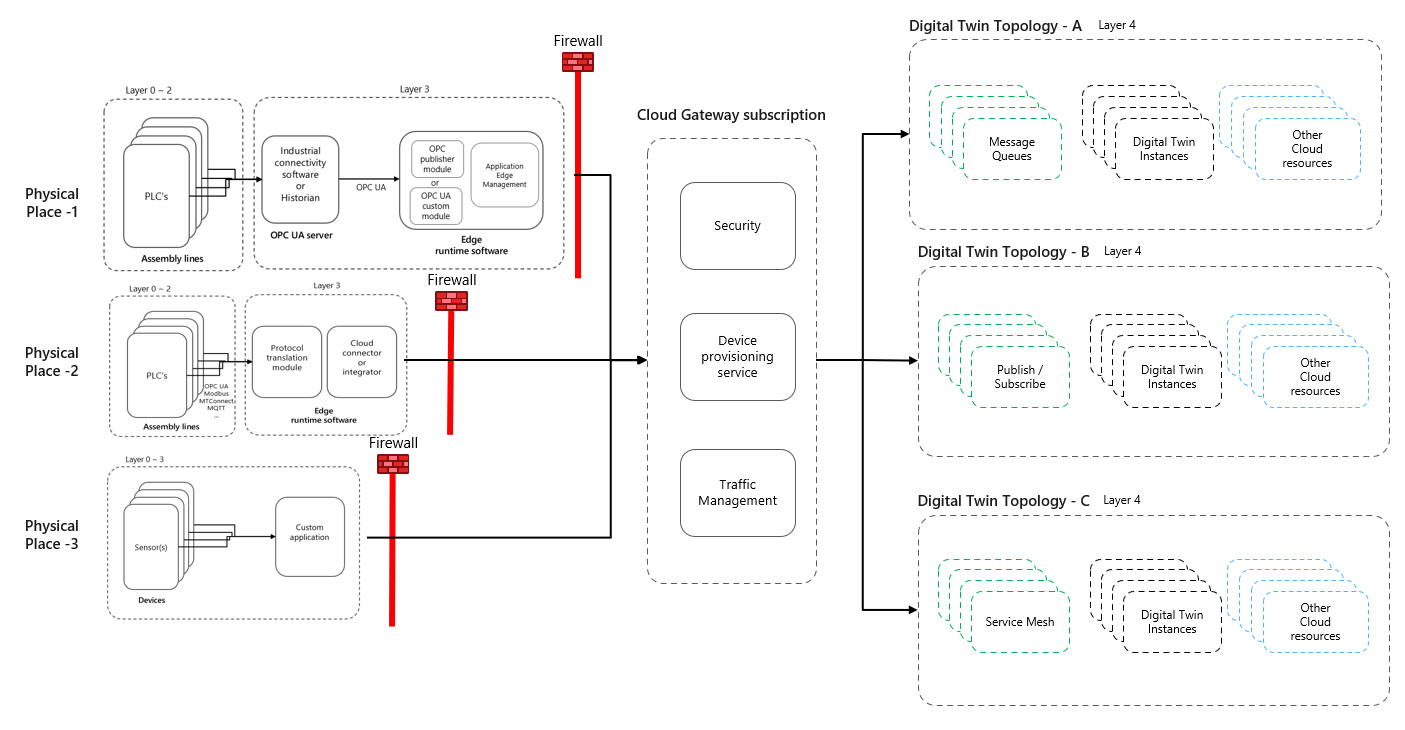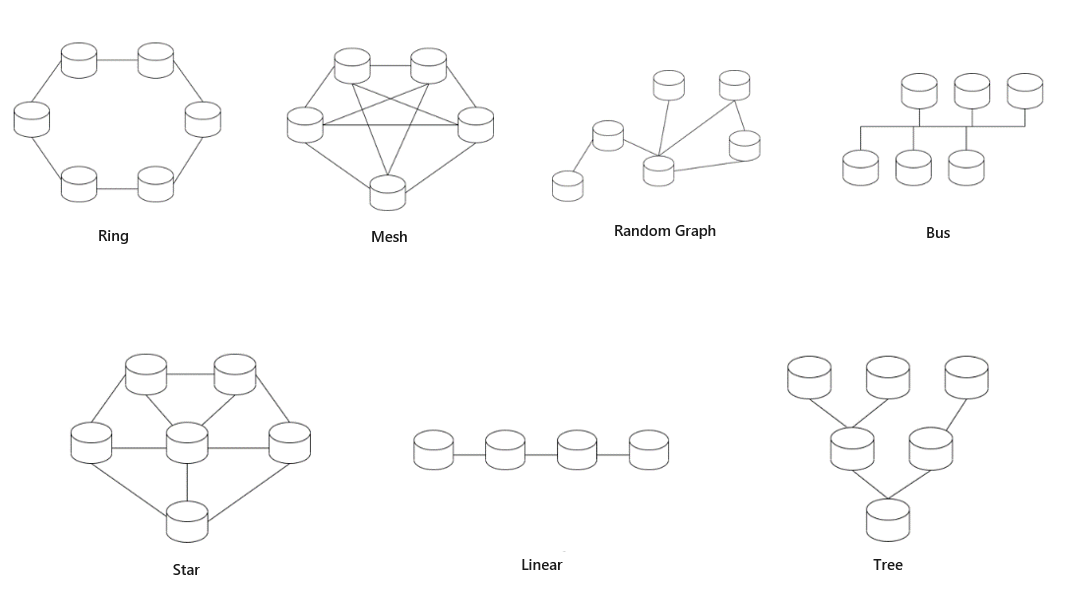By establishing connections between digital twins located in cloud or edge environments, Inter-Twin Communication enables spontaneous discovery and exchange of essential information based on the requirements of their respective physical entities. This breakthrough transcends the constraints of distance and time, facilitating real-time data transmission and collaboration for the physical entities.
For instance, two entities situated far apart, such as a manufacturing unit in Europe and a Industry plant in EEUU, can work together effortlessly. Their digital twins can share and manipulate data, make decisions, and initiate actions that directly impact their physical counterparts without being hindered by geographical or temporal limitations.
This synchronous data exchange holds revolutionary potential across various sectors, from manufacturing to urban planning, wherever real-time, accurate, and efficient data exchange can be advantageous. However, the implementation of Inter-Twin Communication is not without challenges, including ensuring data security, maintaining model accuracy, and managing the complexities and costs of advanced systems.
Inter-Twin Communication presents a prospect of the virtual world surpassing traditional physical limitations and interacting with the physical world. It promises to revolutionize how we understand and manage the interaction between the cyber space and the physical realm, paving the way for a future where collaboration and innovation are not hindered by geographical distance.
Inter-Twin Communication refers to the practice of creating connections between digital twins—virtual representations of physical entities—in cloud or edge environments. This process allows for spontaneous discovery and exchange of crucial information in accordance with the needs of their corresponding physical entities. By transcending the limitations of time and distance, Inter-Twin Communication enables real-time data transmission and collaboration among physical entities.
Table of contents
Open Table of contents
Architecture and Communication Protocols
In the world of Digital Twins, architecture and communication protocols are essential to ensure efficient and secure data transmission. To understand how this communication is established, it is important to become familiar with the structure of the architecture and the protocols involved.
In the context of Digital Twins architectures in the cloud, a dedicated subscription to a cloud gateway is essential for managing outbound traffic to the cloud and connectivity. This becomes especially important when scaling industrial IoT solution patterns across multiple pyshical places, as it enables landing zone cloud connectivity. The device provisioning service plays a vital role in scaling across multiple IoT hubs and cloud IoT management platforms, allowing both IoT hubs and management platforms to leverage the underlying provisioning service for an autoscaling experience. In this architecture, the cloud gateway becomes a crucial component, enabling secure and efficient communication between devices and the cloud, and facilitating scalability as the number of devices increases. By using a device provisioning service, the configuration and registration of new devices in the cloud can be automated, reducing the complexity and time required to integrate new devices into the network. This pattern is particularly useful for scaling cloud gateways and services, and for connecting multiple pyshical places, regardless of data models, protocols, and industrial connectivity software. Together, a dedicated cloud gateway subscription and device provisioning service provide a robust solution for managing connectivity and scalability in Digital Twins and IoT architectures, offering a solid foundation for real-time data collection, analysis, and management in highly connected environments.

- Layer 0: Device and Sensor Layer: Gathers raw data from physical machines and devices.
- Layer 1: Connectivity Layer: Facilitates communication between devices and higher-level systems using protocols.
- Layer 2: Processing and Control Layer: Analyzes and processes data, and can make autonomous decisions based on them.
- Layer 3: Application Management Layer: Hosts applications that interpret and use data for specific functions.
- Layer 4: Enterprise Layer: Integration systems for business-level decision making.
Establishing Inter-Twin Connections
Enable the digital twins to discover and communicate with each other. This can be achieved through various protocols, such as message queues, publish/subscribe mechanisms, service mesh or application programming interfaces (APIs). The goal is to select and implement the best topology that allows data exchange and collaboration.
Digital Twin communication topologies describes how digital twins can communicate with each other in an ecosystem. This concept, known as Inter Twin communication, involves the use of different network topologies (ring, random graph, mesh, bus, tree, linear, star) that determine the structure and interaction patterns among these digital twins. This in turn influences their ability to collaborate and exchange information in real time, depending on the context and use case.
Topologies
-
Ring
- Description: A simple implementation suitable for smaller digital twin systems.
- Advantages: Easy to expand.
- Disadvantages: A single twin failure can cause communication problems.
-
Random Graph
- Description: Connections or splits of the segments can adapt to requirements or domain.
- Advantages: Good resilience, no complete system failure with one component failure.
- Disadvantages: Adaptability may increase complexity.
-
Mesh
- Description: A high density of network interconnection. Suitable for smaller systems.
- Advantages: Very effective and secure.
- Disadvantages: Adding new nodes takes a long time due to the large number of required connections.
-
Bus
- Description: A simple structure that is easy to expand.
- Advantages: Very secure in case of failures.
- Disadvantages: Disruptions have several consequences. Complex access methods can be a disadvantage.
-
Tree
- Description: Offers the option of dividing the digital twins.
- Advantages: Simple, easily expandable structure with a medium level of failure security.
- Disadvantages: Dense wiring can increase complexity.
-
Linear
- Description: A simple, easily expandable structure.
- Advantages: Easy to expand.
- Disadvantages: Poor failure security, as the connection between digital twins would be interrupted if one component fails.
-
Star
- Description: Implements a very effective interconnection.
- Advantages: Easy to expand and offers good reliability.
- Disadvantages: Central component failure affects the whole system. Represents a very centralized approach.

Inter-Twin Communication between Digital Twin instances.
In the following examples you can find some generic and illustrative implementations that can use different cloud resources depending on your need and the cloud provider. For each use case, the communication implementation used must be replaced by that of the selected cloud resource.
Subscribe to events related to changes
In this adapted example, the Digital Twin is represented as a digital twin of a physical asset. This digital twin is hosted in the cloud and uses a generic resource (in this case, the resource is a temperature measured in an environment). The Digital Twin can generate events related to changes in temperature and process these events. An EventChannel is used to manage event subscription and event publishing between multiple Digital Twins.
import requests
class Event:
def __init__(self, name, data):
self.name = name
self.data = data
class DigitalTwin:
def __init__(self, name, endpoint):
self.name = name
self.endpoint = endpoint # Endpoint for the cloud-based Digital Twin service
def generate_event(self, name, data):
return Event(name, data)
def process_event(self, event):
print(f'DigitalTwin {self.name} processed event {event.name} with data {event.data}')
# Send the event data to the cloud service
requests.post(self.endpoint, json={'event': event.name, 'data': event.data})
class EventChannel:
def __init__(self):
self.subscribers = {}
def subscribe(self, event_name, subscriber):
if event_name not in self.subscribers:
self.subscribers[event_name] = []
self.subscribers[event_name].append(subscriber)
def publish(self, event):
if event.name in self.subscribers:
for subscriber in self.subscribers[event.name]:
subscriber.process_event(event)
# Cloud endpoints for the Digital Twins
cloud_endpoint_twin1 = 'https://cloud.example.com/digital-twin/Twin1'
cloud_endpoint_twin2 = 'https://cloud.example.com/digital-twin/Twin2'
# Initialize Event Channel
event_channel = EventChannel()
# Initialize two Digital Twins and subscribe them to an event
twin1 = DigitalTwin('Twin1', cloud_endpoint_twin1)
twin2 = DigitalTwin('Twin2', cloud_endpoint_twin2)
event_channel.subscribe('TemperatureChange', twin1)
event_channel.subscribe('TemperatureChange', twin2)
# Generate an event
event = twin1.generate_event('TemperatureChange', {'temperature': 75})
# Publish the event
event_channel.publish(event)
Direct communication between the Digital Twins
Here is an example of how communication can be achieved between two Digital Twins in the cloud. In this example, in addition to events, a method of direct communication between the Digital Twins is introduced. Each Digital Twin can communicate directly with another Digital Twin by sending data to their endpoint in the cloud. In this case, the Digital Twins send hello messages to each other. This direct communication is implemented using the communicate function, which allows one Digital Twin to send data directly to another Digital Twin through its cloud endpoint.
import requests
class Event:
def __init__(self, name, data):
self.name = name
self.data = data
class DigitalTwin:
def __init__(self, name, endpoint):
self.name = name
self.endpoint = endpoint # Endpoint for the cloud-based Digital Twin service
def generate_event(self, name, data):
return Event(name, data)
def process_event(self, event):
print(f'DigitalTwin {self.name} processed event {event.name} with data {event.data}')
# Send the event data to the cloud service
requests.post(self.endpoint, json={'event': event.name, 'data': event.data})
def communicate(self, target_endpoint, data):
# Communicate directly with another Digital Twin
print(f'DigitalTwin {self.name} sending data to {target_endpoint}')
requests.post(target_endpoint, json=data)
class EventChannel:
def __init__(self):
self.subscribers = {}
def subscribe(self, event_name, subscriber):
if event_name not in self.subscribers:
self.subscribers[event_name] = []
self.subscribers[event_name].append(subscriber)
def publish(self, event):
if event.name in self.subscribers:
for subscriber in self.subscribers[event.name]:
subscriber.process_event(event)
# Cloud endpoints for the Digital Twins
cloud_endpoint_twin1 = 'https://cloud.example.com/digital-twin/Twin1'
cloud_endpoint_twin2 = 'https://cloud.example.com/digital-twin/Twin2'
# Initialize Event Channel
event_channel = EventChannel()
# Initialize two Digital Twins and subscribe them to an event
twin1 = DigitalTwin('Twin1', cloud_endpoint_twin1)
twin2 = DigitalTwin('Twin2', cloud_endpoint_twin2)
event_channel.subscribe('TemperatureChange', twin1)
event_channel.subscribe('TemperatureChange', twin2)
# Generate an event
event = twin1.generate_event('TemperatureChange', {'temperature': 75})
# Publish the event
event_channel.publish(event)
# Example of direct communication between the two Digital Twins
twin1.communicate(twin2.endpoint, {'message': 'Hello Twin2, this is Twin1!'})
twin2.communicate(twin1.endpoint, {'message': 'Hello Twin1, this is Twin2!'})
Publish and subscribe mechanism communication between the Digital Twins
In this example, each Digital Twin subscribes to events posted by the other. When a Digital Twin wants to communicate with the other, he posts an event with a message. The other Digital Twin, which is subscribed to that event, will process and respond to it in a similar way. In this way, the Digital Twins can communicate with each other using a publish and subscribe mechanism managed by the event channel (EventChannel).
class Event:
def __init__(self, name, data):
self.name = name
self.data = data
class DigitalTwin:
def __init__(self, name, event_channel):
self.name = name
self.event_channel = event_channel
def generate_event(self, name, data):
return Event(name, data)
def process_event(self, event):
print(f'DigitalTwin {self.name} processed event {event.name} with data {event.data}')
def publish_event(self, event):
self.event_channel.publish(event)
def subscribe(self, event_name):
self.event_channel.subscribe(event_name, self)
class EventChannel:
def __init__(self):
self.subscribers = {}
def subscribe(self, event_name, subscriber):
if event_name not in self.subscribers:
self.subscribers[event_name] = []
self.subscribers[event_name].append(subscriber)
def publish(self, event):
if event.name in self.subscribers:
for subscriber in self.subscribers[event.name]:
subscriber.process_event(event)
# Initialize Event Channel
event_channel = EventChannel()
# Initialize two Digital Twins and subscribe them to an event
twin1 = DigitalTwin('Twin1', event_channel)
twin2 = DigitalTwin('Twin2', event_channel)
# Subscribe to each other's events
twin1.subscribe('MessageFromTwin2')
twin2.subscribe('MessageFromTwin1')
# Twin1 sends a message to Twin2
event = twin1.generate_event('MessageFromTwin1', {'message': 'Hello Twin2, this is Twin1!'})
twin1.publish_event(event)
# Twin2 sends a message to Twin1
event = twin2.generate_event('MessageFromTwin2', {'message': 'Hello Twin1, this is Twin2!'})
twin2.publish_event(event)